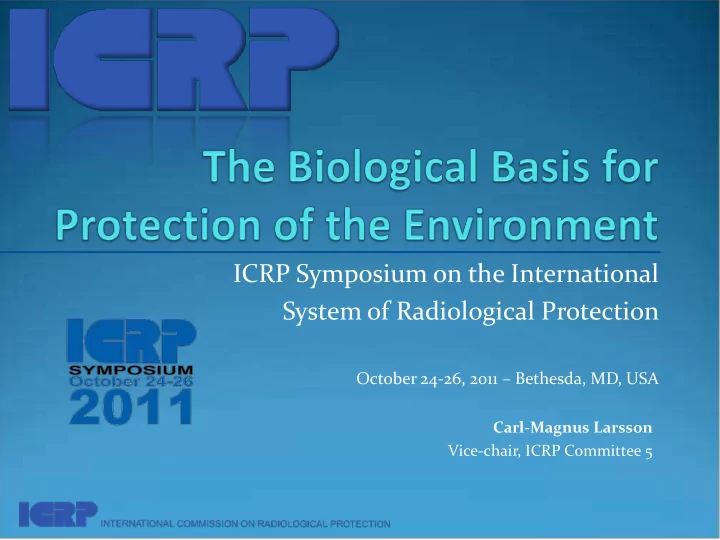

ICRP Symposium on the International System of Radiological Protection October 24-26, 2011 – Bethesda, MD, USA Carl-Magnus Larsson Vice-chair, ICRP Committee 5
The ethical basis Benchmarks BIOLOGY Compliance ICRP System for Environmental Radiation Protection 2
Protection of the ....or, for the benefit of environment in its own mankind right and for its own good.....
Anthropocentrism Non-anthropocentrism Biocentrism – individual life forms have value in themselves that should be respected – not only because they affect the situation of humans Ecocentrism – general concern for biotic and abiotic community as a whole 4
Principles in International Instruments: activities within a jurisdiction should not cause damage to the environment of other States; maintain ecosystems and processes that are essential for the functioning of the biosphere; maintain biodiversity: and observe the ‘principle’ of optimum sustainable yield in the use of living natural resources 5
Review of ethics and principles, recommending that the System for Environmental Protection should focus on biota; consider adequate protection on the basis of understanding of effects; identify reference animals and plants (RAPs); and let the RAPs guide the derivation of exposure scenarios (CFs and DCFs) effects data dose rates benchmarks
(30) ….aim is…preventing and reducing the frequency of deleterious radiation effects to a level where they would have negligible impact on the maintenance of biological diversity , the conservation of species , or the health and status of natural habitats , communities and ecosystems . (366) .....Reference Animals and Plants.......
WILDLIFE GROUP RAP Large terrestrial mammals Deer Small terrestrial mammals Rat Aquatic birds Duck Amphibians Frog Freshwater pelagic fish Trout Marine fish Flatfish Terrestrial insects Bee Marine crustaceans Crab Terrestrial annelids Earthworm Large terrestrial plants Pine tree Small terrestrial plants Wild grass Seaweeds Brown seaweed
ICRP 108 reviews biological characteristics Occurrence Taxonomy Life cycle and life span Reproductive strategy Physiology Ecology .....other factors.....
Decision Broader P108 context P114 Application RP and EP TG82 C5 DCRL RAP Dose/Effect/Response Outside scope Dose rate Dispersion RAP Transfer DCC RAP CR Organism biology and ecology
Concentration Ratios for 39 elements and 12 RAPs with associated statistics; based on existing field and laboratory data; using new methodology to derive data (‘surrogate data’) where such are missing; taking in to account life cycle stages and habitats, when possible; and discussing the robustness of the data 11
Trunk and branch 12
Ecosystem Population Ecosystem Severity of Individual (all stressors) observed effect RAP Cells and Tissues (radiation) Molecular
Other a Ecosystem External Internal Total number (%) Total number (%) (number of of data references) acute 12273 (61.4) 11564 288 421 Terrestrial chronic 6795 (34.0) 3449 344 3002 19983 (72.6) transitory b (579) 913 (4.57) 670 40 203 not stated 2 (0.03) 0 0 2 acute 4526 (74.6) 4058 97 371 chronic 1484 (24.5) 970 20 494 Freshwater 6067 (22.0) (195) transitory 54 (0.89) 12 2 40 not stated 3 (0.01) 0 0 3 acute 1116 (75.9) 995 58 63 Marine chronic 353 (24.1) 286 0 67 1470 (5.4) (45) transitory 0 (0) 0 0 0 not stated 1 (0) 0 0 1
ICRP 108 , international and national research projects, UNSCEAR 2008 (Vol II Annex E) Mortality Morbitity Reduced reproductive success Mutation (multiple endpoints, consideration of RBE)
Species Sensitivity Distribution (SSD) approach (all data, all endpoints, weighted) Small data set approach (individual species, individual enpoints) Deterministic, expert judgement approach (weighted, extrapolated)
R² = 0.9467 SSD - Log Normal KSpvalue = 0.500 100% Cumulative weighted probability 90% 80% 70% 60% 50% 40% 30% 20% 10% 0% 0.1 1 10 100 1000 10000 100000 1000000 10000000 Dose rate (µGy/h) Best-Estimate Centile 5% Centile 95% Vertebrates Plants Invertebrates
DCRLs mGy d -1 Pine Grass Seaweed Mortality of some trees Reduced reproductive No information* 100-1000 after prolonged exposure. capacity [46 Gy LD 50 at 130 mGy d - 1 ] 10-100 Mortality of some trees Reduced reproductive No information after very long exposure capacity [76 Gy LD 50 at ~30 mGy d - 1 for ten years] Growth defects. • Reduced reproductive • success. 1-10 Morbidity as expressed No information No information through anatomical and morphological damage. Prolonged exposure leads to reduced reproductive success. 0.1-1 No information No information No information 0.01 – 0.1 No information No information No information
DCRLs Benchmarks from other studies 1000 100 mGy/d 10 Invertebrate benchmark Seaweed Crab Earthworm Bee Plant benchmark 1 Frog Trout Flatfish Grass Generic benchmark 0.1 Vertebrate benchmark Deer Rat Duck Pine tree 0.01 Background level 0.001
DCRLs – help consider radiation effects data alongside other information, e.g. data relate to actual or theoretical studies, the type of exposure situation the size of the area affected, the status of the population, the fraction of a population exposed, and the legal framework within which management action are taken other stressors In order to characterise the risk
www.icrp.org
Recommend
More recommend